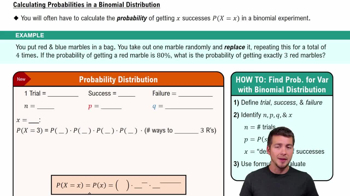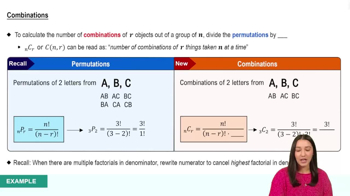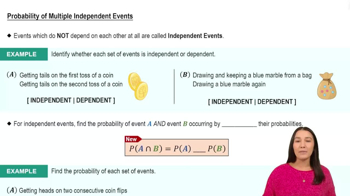Based on historical weather data in a certain city, about 62% of the days are cloudy. Find the mean, standard deviation, and variance for the number of cloudy days in a 30-day month.
Table of contents
- 1. Intro to Stats and Collecting Data1h 14m
- 2. Describing Data with Tables and Graphs1h 55m
- 3. Describing Data Numerically2h 5m
- 4. Probability2h 16m
- 5. Binomial Distribution & Discrete Random Variables3h 6m
- 6. Normal Distribution and Continuous Random Variables2h 11m
- 7. Sampling Distributions & Confidence Intervals: Mean3h 23m
- Sampling Distribution of the Sample Mean and Central Limit Theorem19m
- Distribution of Sample Mean - Excel23m
- Introduction to Confidence Intervals15m
- Confidence Intervals for Population Mean1h 18m
- Determining the Minimum Sample Size Required12m
- Finding Probabilities and T Critical Values - Excel28m
- Confidence Intervals for Population Means - Excel25m
- 8. Sampling Distributions & Confidence Intervals: Proportion1h 12m
- 9. Hypothesis Testing for One Sample3h 29m
- 10. Hypothesis Testing for Two Samples4h 50m
- Two Proportions1h 13m
- Two Proportions Hypothesis Test - Excel28m
- Two Means - Unknown, Unequal Variance1h 3m
- Two Means - Unknown Variances Hypothesis Test - Excel12m
- Two Means - Unknown, Equal Variance15m
- Two Means - Unknown, Equal Variances Hypothesis Test - Excel9m
- Two Means - Known Variance12m
- Two Means - Sigma Known Hypothesis Test - Excel21m
- Two Means - Matched Pairs (Dependent Samples)42m
- Matched Pairs Hypothesis Test - Excel12m
- 11. Correlation1h 6m
- 12. Regression1h 50m
- 13. Chi-Square Tests & Goodness of Fit1h 57m
- 14. ANOVA1h 57m
5. Binomial Distribution & Discrete Random Variables
Binomial Distribution
Problem 5.2.13b
Textbook Question
Binomial Probability Formula. In Exercises 13 and 14, answer the questions designed to help understand the rationale for the binomial probability formula.
Guessing Answers Standard tests, such as the SAT, ACT, or Medical College Admission Test (MCAT), typically use multiple choice questions, each with five possible answers (a, b, c, d, e), one of which is correct. Assume that you guess the answers to the first three questions.
b. Beginning with WWC, make a complete list of the different possible arrangements of two wrong answers and one correct answer, and then find the probability for each entry in the list.
 Verified step by step guidance
Verified step by step guidance1
Step 1: Understand the problem. You are tasked with listing all possible arrangements of two wrong answers (W) and one correct answer (C) for three questions, and then calculating the probability for each arrangement. This involves understanding the binomial probability formula and basic combinatorics.
Step 2: List all possible arrangements of two wrong answers and one correct answer. Since there are three questions, the arrangements can be represented as permutations of the letters 'WWC'. These include: WWC, WCW, CWW. Ensure you account for all possible orders.
Step 3: Calculate the probability of each arrangement. For each question, there is a 1/5 chance of guessing correctly (C) and a 4/5 chance of guessing incorrectly (W). The probability of a specific arrangement is the product of the probabilities for each position. For example, for WWC: \( P(WWC) = \left( \frac{4}{5} \right) \times \left( \frac{4}{5} \right) \times \left( \frac{1}{5} \right) \).
Step 4: Repeat the probability calculation for each arrangement (WCW and CWW). The probabilities will be the same for all arrangements because the number of correct and wrong answers is fixed, and the positions are equally likely.
Step 5: Summarize the results. Once you have calculated the probability for each arrangement, you can confirm that the sum of probabilities across all arrangements equals the total probability of having two wrong answers and one correct answer in three questions. This is consistent with the binomial probability formula.
 Verified video answer for a similar problem:
Verified video answer for a similar problem:This video solution was recommended by our tutors as helpful for the problem above
Video duration:
4mPlay a video:
Was this helpful?
Key Concepts
Here are the essential concepts you must grasp in order to answer the question correctly.
Binomial Probability
The binomial probability formula is used to calculate the likelihood of a specific number of successes in a fixed number of independent trials, each with two possible outcomes (success or failure). It is expressed as P(X = k) = (n choose k) * p^k * (1-p)^(n-k), where n is the number of trials, k is the number of successes, and p is the probability of success on a single trial.
Recommended video:
Guided course

Calculating Probabilities in a Binomial Distribution
Combinations
Combinations refer to the selection of items from a larger set where the order does not matter. In the context of the binomial probability formula, combinations are used to determine how many different ways a certain number of successes can occur among the trials. The formula for combinations is given by n choose k = n! / (k!(n-k)!), where n is the total number of items and k is the number of items to choose.
Recommended video:

Combinations
Probability of Events
Probability quantifies the likelihood of an event occurring, ranging from 0 (impossible) to 1 (certain). In the context of guessing answers on a multiple-choice test, the probability of selecting the correct answer is 1/5, while the probability of selecting a wrong answer is 4/5. Understanding these probabilities is essential for calculating the overall probability of different outcomes when guessing answers.
Recommended video:

Probability of Multiple Independent Events

 6:00m
6:00mWatch next
Master The Binomial Experiment with a bite sized video explanation from Patrick
Start learningRelated Videos
Related Practice
Multiple Choice
